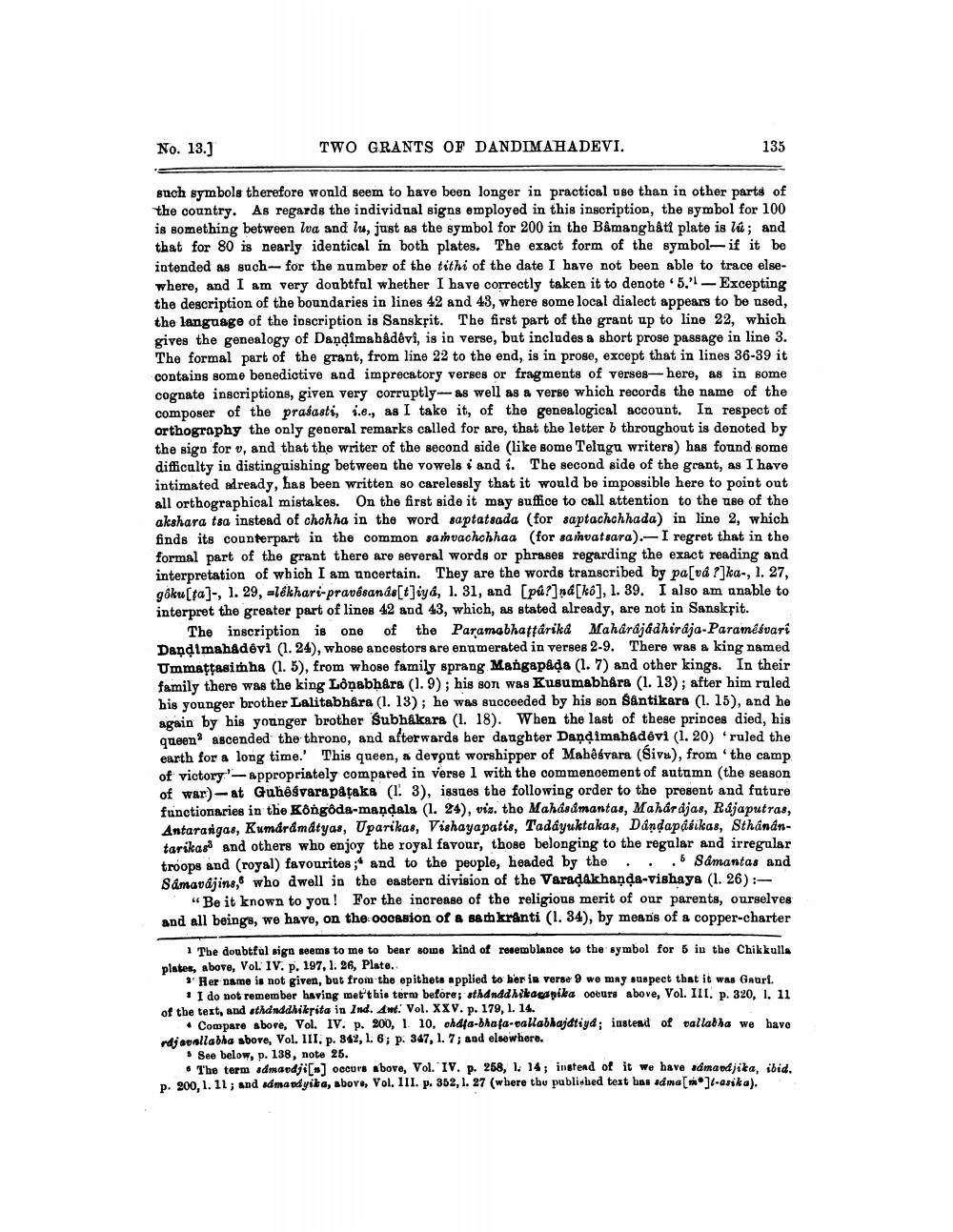________________
No. 13.)
TWO GRANTS OF DANDIMAHADEVI.
135
such symbols therefore would seem to have been longer in practical use than in other parts of the country. As regards the individual signs employed in this inscription, the symbol for 100 is something between lva and lu, just as the symbol for 200 in the Bâmanghati plate is lú; and that for 80 is nearly identical in both plates. The exact form of the symbol - if it be intended as such for the number of the tithi of the date I have not been able to trace elsewhere, and I am very doubtful whether I have correctly taken it to denote. 5.' -Excepting the description of the boundaries in lines 42 and 43, where some local dialect appears to be used, the language of the inscription is Sanskřit. The first part of the grant up to line 22, which gives the genealogy of Dandimahadevi, is in verse, but includes a short prose passage in line 3. The formal part of the grant, from line 22 to the end, is in prose, except that in lines 36-39 it contains some benedictive and imprecatory verses or fragments of verses-here, as in some cognate inscriptions, given very corruptly-88 well as a verse which records the name of the composer of the prasasti, s.c., as I take it, of the genealogical account. In respect of orthography the only general remarks called for are, that the letter b throughout is denoted by the sign for o, and that the writer of the second side (like some Telugu writers) has found some difficulty in distinguishing between the vowels i and i. The second side of the grant, as I have intimated adready, has been written so carelessly that it would be impossible here to point out all orthographical mistakes. On the first side it may suffice to call attention to the use of the akshara tsa instead of chokha in the word saptatsada (for saptachchhada) in line 2, which finds its counterpart in the common sa invachchhaa (for samvatsara).- I regret that in the formal part of the grant there are several words or phrases regarding the exact reading and interpretation of which I am uncertain. They are the words transcribed by pa[vá ?]ka-, 1. 27, gôku (tal., 1. 29, =lékhari-pravesande[t]iya, 1. 31, and (pů?]nd[ko], 1. 39. I also am anable to interpret the greater part of lines 42 and 43, which, as stated already, are not in Sanskrit.
The inscription is one of the Paramabhatfárika Maharajadhiraja-Paramétvari Dandimahadevi (1. 24), whose ancestors are enumerated in verses 2-9. There was a king named Ummaţtasimha (1.5), from whose family sprang Mengapada (1. 7) and other kings. In their family there was the king Lôņabhara (1.9); his son was Kusumabhara (1. 13); after him ruled his younger brother Lalitabhara (1. 13); he was succeeded by his son Santikara (1. 15), and he again by his younger brother Subhakara (1. 18). When the last of these princes died, his queen ascended the throno, and afterwards her daughter Dandimahadevi (1. 20) ruled the earth for a long time. This queen, a devout worshipper of Mahêśvara (Sivu), from the camp of victory.' - appropriately compared in verse l with the commencement of autumn (the season of war) - at Guhêsvarapataka (1. 3), issues the following order to the present and future functionaries in the Kôngôda-mandala (1. 24), vis. the Mahasamantas, Maharajas, Rájaputras, Antararigas, Kumdrámdtyas, Uparikas, Vishayapatis, Tadayuktakas, Dandapafikas, Sthanantarikasi and others who enjoy the royal favour, those belonging to the regular and irregular troops and (royal) favourites ;* and to the people, headed by the .. . Samantas and Samavajins, who dwell in the eastern division of the Varadakhanda-vishaya (1. 26) :
"Be it known to you! For the increase of the religious merit of our parents, ourselves and all beings, we have, on the occasion of a sam kranti (1. 34), by means of a copper-charter
1 The doubtfal siga seems to me to bear some kind of resemblance to the symbol for 5 in the Chikkulla plates, above, Vol. IV. p. 197, 1. 26, Plate.
Her name is not given, but from the epithets applied to her in verse 9 wo may suspect that it was Gauri.
: I do not remember having met this term before; sthanddukanapika coburs above, Vol. III. p. 320, 1. 11 of the text, and othduddhikrita in Ind. Am Vol. XXV. p. 179, 1. 14.
• Compare above, Vol. IV. p. 200, 1. 10, chdta-bhafa-callabhajdtiyd; instead of balladha we have rdjevnllabha sbore, Vol. III. p. 342, 1. 6; p. 347, 1. 7; and elsewhere.
* See below, p. 138, note 26.
6 The term sámardji[] occurs above, Vol. IV. p. 258, 1. 14; instend of it we have samardjika, ibid. p. 200, 1. 11; and samadyika, above, Vol. 111. p. 352, 1. 27 (where the published text bas same[*]l-asika).




